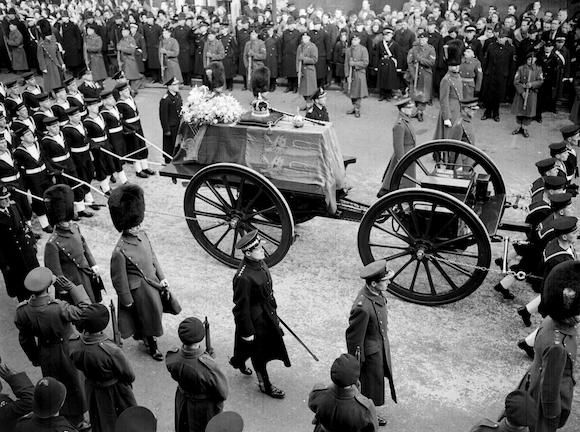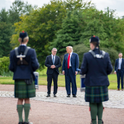The life of Prince Philip, Duke of Edinburgh, virtually straddled the century between Spanish flu and Covid-19. His official departure, coinciding with our pandemic, will be gravely affected by it. So will the monarchy itself. This is because the elaborate funeral arrangements which have marked the demise of major royal figures since the time of Queen Victoria will be drastically curtailed.
The Duke wanted to be interred without fuss, and in ceremonial terms he is going to get his wish. The congregation at St George’s Chapel will be limited to 30 people and even laying flowers has been discouraged. So the display on which the sovereign and her family rely to vitalise their connection with the people will be in abeyance. Royalty, like the rest of us, will have to endure a measure of isolation and will thereby be diminished.
Of course, the media has done its best to enhance Philip’s iconic status, providing blanket coverage not seen since Princess Diana’s death. With plenty of time to prepare their farewells, the BBC and other TV channels have broadcast sonorous Te Deums—provoking a record number of complaints. The Beefeater press has indulged in an orgy of adulation, its tenor best expressed in the Sun’s headline: “We’re all weeping with you, Ma’am.” Even the avowedly republican Guardian has joined the chorus, its columnist Simon Jenkins describing the “effortlessly gracious” Duke as “perfectly cast” for the role of consort to the Queen. As was said after the death of Queen Victoria, whom the Daily Telegraph hailed as the “greatest of the good,” all the newspapers seem to be edited by undertakers.
There is indeed nothing new about such effusions. Thackeray remarked on the “trumpery panegyrists” who saluted dead princes. Their “monstrous threnodies,” especially when uttered from the pulpit, were ghastly forms of royal ceremonial. He excoriated “the lying eulogies, the blinking of disagreeable truths, the sickening flatteries, the simulated grief, the falsehood and the sycophancies.” After the demise of Edward VII, the diarist Wilfrid Scawen Blunt thought that the nation was suffering from a delirium and hoped it would soon return to comparative sanity. Writers had ascribed to the late King such merits that “he might have been a Solon and a Francis of Assisi combined if the characters drawn of him were true.”
The problem with verbal tributes is that the more extravagant they become, the less credible they are. In any case, actions speak louder than words. Imagery is more potent than obituary. What counts for most is the regal passing-out parade, the last rites of mortality. A royal funeral is, to paraphrase Walter Bagehot, a brilliant edition of a universal fact. And during the past century such events have been staged with increasing pomp, so as to constitute an act of communion between sovereign and subject.
It began with the funeral of Queen Victoria in 1901. Actually, the arrangements were bungled by the Heralds of the College of Arms—“ghastly cads,” said a courtier, “not a gent among them.” Furthermore, the harness attaching horses to the gun carriage broke and it had to be pulled by the naval guard of honour, creating an instant tradition. But the procession of the cortège through the capital prompted an atavistic response from onlookers, as described by John Galsworthy in The Forsyte Saga: “There it was—the bier of the Queen, coffin of the Age slowly passing! And as it went by there came a mourning groan from all the long line of those who watched, a sound such as Soames had never heard, so unconscious, primitive, deep and wild.” It was, said Galsworthy, a tribute of the age to its own death.
Her son Edward VII’s funeral nine years later was scarcely better managed, but it drew even larger crowds. Moreover, his widow Queen Alexandra, riding in the scarlet and gold state coach and raising her veil to bow to the weeping multitudes, established a palpable rapport with them. For the first time, too, the body of a sovereign lay in state in Westminster Hall. Archbishop Randall Davidson, impresario to majesty, inaugurated this change, overcoming objections that the scene of Charles I’s trial was an inauspicious venue. Davidson’s aim was to identify monarchy with democracy. And in this he was successful, if the remark of one of the “reverent” working-class women in the enormous queue is to be believed: “They’re givin’ ’im to us now!”
Davidson was not alone in perceiving that theatrical obsequies dramatised royal deaths, inspiring intense feelings of sympathy and loyalty. Tolling bells, muffled drums, skirling pipes, marching boots, minute guns, solemn dirges, sepulchral incantations—all had their power to move. They even had a transformative power. Unlike Vespasian, Bertie did not become a god, but as the focus of stately lamentation he did metamorphose from Edward the Caresser to the father of his people.
As it happened the hecatombs of the Western Front would soon abate the excesses of the Victorian way of death—black crepe, plumed horses, ornate obelisks and so on. Most people’s funerals became simpler to match the grim circumstances in which a whole generation of Britons had gone to their graves. Yet royalty took the opposite course, celebrating the passing of its members with enough ostentation to satisfy the most ardent necrophiliac.
George V’s funeral was, as his successor wrote, a “brilliant and impressive spectacle.” Its panoplied centrepiece was once again the lying-in-state at Westminster Hall, where nearly a million people shuffled past the corpse. One evening, seeking to augment his father’s propaganda value, Edward and his three brothers spent 20 minutes standing guard with swords reversed around the magnificent catafalque. (Prince Charles will do the same when the Queen dies.) In truth this was the kind of “stunt” for which the old King had angrily condemned the then-Prince of Wales. But newspapers hailed the vigil as an unexampled act of filial piety. Such histrionic gestures convinced the novelist Compton Mackenzie that the new monarch Edward VIII, who would abdicate within a year, possessed “the genius of royalty.”

Radio played a key part in bringing the funerals of both George V and George VI into the homes of the populace. The ceremonies became “aural pageants.” None was more mellifluous than Richard Dimbleby, who famously intoned about George VI’s lying-in-state: “Never safer, better guarded, lay a sleeping king than this, with a golden candle-light to warm his resting place and the muffled footsteps of his devoted subjects to keep him company.” The cinema newsreels, soon to be overtaken by television, displayed the pharaonic grandeur of this occasion. Movietone projected onto the screen a huge elegiac tableau framed by massed ranks of mourners, all sombrely still during the two minutes’ silence. Meanwhile the commentator, Leslie Mitchell, announced in lapidary tones that the prevailing atmosphere of sympathy and sorrow touched the heart and harrowed the soul.
Prince Philip’s uncle, Lord Mountbatten, claimed not to care what form his own funeral took. He then devised in meticulous detail a Cecil B DeMille production of his own, with 1,400 guests, six cushions to bear his decorations, a gun carriage pulled by 130 sailors, and his horse Dolly on parade with his black thigh-boots poignantly reversed in the stirrups. It was an event, Mountbatten joked, that he would be sad to miss.
In deference to Philip’s wishes, his own “life of duty and service,” authoritatively extolled this week by Prince Andrew, should have culminated in a less baroque affair. Nevertheless, but for coronavirus Operation Forth Bridge, as his funeral plans were code-named, would have been an imposing performance, with 800 attendees and a heavy naval presence.
Certainly, Philip had cause to appreciate the crucial role that obsequies could play in the life of the country and the monarchy. During the fraught days after Princess Diana’s death, the court tried to sustain its policy of airbrushing her out of the royal picture. No prayers were offered for her at Crathie Church because she had been stripped of the HRH title. No orders were given to fly the Palace flag at half-mast. Instead, plans were made to have a short processional route and a semi-private service.
All this changed, of course, when the Queen faced unprecedented criticism for being out of touch with the mood of her subjects. To assuage it the Princess was given what amounted to a state funeral—defined by the 17th Duke of Norfolk as a funeral paid for by the state. The ceremonial was sumptuous and the choreography impeccable. The Queen made a slight bow to the coffin. The stricken young princes brought tears to the eyes of many of the 2.5bn television viewers round the world. Earl Spencer’s address produced a vast catharsis. In death the Princess breathed life into the royal mystique.
Philip’s funeral promises to be the antithesis of hers. Too modest to generate serious popular emotion, it will give the monarchy no comparable charge.












